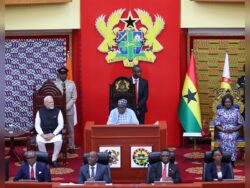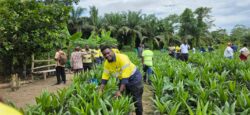The energy sector crisis in emerging markets has become a critical challenge, characterized by power shortages, over-reliance on fossil fuels, weak infrastructure, and limited access to clean energy.
Countries across Africa, Latin America, and parts of Asia face persistent energy deficits that hinder economic growth, industrialization, and social development (World Bank, 2023).
As demand for electricity rises with growing populations and industrial activities, many emerging economies struggle to meet their energy needs due to financial constraints, regulatory inefficiencies, and external shocks such as supply chain disruptions and geopolitical tensions.
This article explores energy crises in emerging markets and examines successful strategies implemented in Europe, Asia, and the United States to address similar challenges.
By drawing lessons from these cases, emerging economies can formulate sustainable solutions to enhance energy security, diversify energy sources, and promote resilience in the power sector.
Energy Crises in Emerging Markets:
Nigeria: Chronic Power Shortages and Over-Reliance on Fossil Fuels
Nigeria, Africa’s largest economy, has long suffered from an energy crisis marked by inadequate electricity supply, frequent blackouts, and heavy dependence on diesel and petrol generators.
Despite having an installed generation capacity of over 13,000 megawatts (MW), the country struggles to supply even 5,000 MW due to aging infrastructure, gas supply constraints, and poor transmission networks (International Energy Agency [IEA], 2023).
South Africa: Load Shedding and Energy Dependence on Coal
South Africa’s energy crisis is primarily due to Eskom, the state-owned power utility, struggling to maintain its coal-powered plants.
The country has experienced rolling blackouts (load shedding) since 2007, with Eskom failing to generate enough electricity to meet demand. As of 2023, load shedding was implemented for up to 10 hours daily, severely impacting businesses, manufacturing, and economic growth (South African Reserve Bank, 2024).
India: Rural Electrification Challenges and Rising Energy Demand
India has made significant strides in expanding electricity access through initiatives such as the Saubhagya Scheme, which brought power to over 26 million rural households between 2017 and 2022 (Ministry of Power, India, 2023).
However, challenges remain in meeting the country’s soaring energy demand due to rapid urbanization and industrial expansion.
Lessons from Developed Markets in Tackling Energy Crises
Europe: Energy Security Amidst the Russia-Ukraine War
The European Union (EU) faced a major energy crisis in 2022 following the Russia-Ukraine war, which disrupted natural gas supplies from Russia.
Before the crisis, 40% of the EU’s gas imports came from Russia, leaving many European countries vulnerable when Russia cut gas flows in retaliation against Western sanctions (European Commission, 2023).
To mitigate the crisis, Europe implemented multiple strategies:
- Diversification of Energy Sources: The EU turned to alternative suppliers such as Norway, the U.S. (Liquefied Natural Gas – LNG), and North Africa.
- Expansion of Renewable Energy: Germany accelerated its offshore wind projects, aiming for 30 GW of offshore wind capacity by 2030 (Federal Ministry for Economic Affairs and Climate Action, Germany, 2024).
- Energy Conservation Measures: Several countries introduced incentives for energy efficiency, including financial aid for households and businesses to reduce consumption.
These measures helped stabilize the European energy market, reducing dependency on Russian gas while increasing sustainability. Emerging markets can replicate such strategies by diversifying their energy mix and fostering regional energy partnerships.
Asia: Japan’s Response to the Fukushima Nuclear Disaster
Japan faced a severe energy crisis following the 2011 Fukushima Daiichi nuclear disaster, which led to the shutdown of the country’s nuclear power plants.
The loss of nuclear energy (which supplied 30% of Japan’s electricity) forced the country to increase reliance on expensive LNG and coal imports (Japan Ministry of Economy, Trade and Industry, 2023).
To address the crisis, Japan adopted the following approaches:
- Investment in Renewable Energy: Japan rapidly expanded its solar and wind energy infrastructure, introducing feed-in tariffs (FITs) to encourage private-sector investment.
- Energy Efficiency Programs: The government launched “Setsuden” (power-saving) campaigns, promoting energy conservation through regulatory and behavioral changes.
- Gradual Nuclear Restart: After extensive safety upgrades, Japan restarted select nuclear reactors under stricter regulations.
These strategies enabled Japan to restore energy stability while transitioning toward cleaner alternatives. Emerging markets can benefit by adopting energy efficiency programs and encouraging renewable energy investments.
United States: Texas Power Crisis and Grid Resilience
In February 2021, Texas experienced a catastrophic energy crisis due to an unprecedented winter storm, which caused widespread power failures affecting 4.5 million people and resulting in billions of dollars in economic losses (U.S. Energy Information Administration, 2022).
Key factors behind the crisis included:
- Over-reliance on Natural Gas: The Texas grid, managed by ERCOT, depended heavily on natural gas, which failed due to frozen infrastructure.
- Lack of Grid Interconnection: Texas operates its own isolated power grid, limiting access to external energy sources.
To enhance energy resilience, Texas adopted several reforms:
- Winterization of Energy Infrastructure: New regulations required power plants to withstand extreme weather conditions.
- Diversification with Renewables: Texas expanded wind and solar capacity, reinforcing its grid against future disruptions.
These measures underscore the importance of grid resilience, climate adaptation, and energy diversification, which emerging economies must consider when designing long-term energy policies
The Way Forward for Emerging Markets
Emerging economies face persistent energy challenges due to aging infrastructure, over-reliance on fossil fuels, lack of investment, and policy inefficiencies.
Addressing these issues requires a multi-faceted approach that enhances energy security, sustainability, and affordability.
The following breakdown details key strategies that can help emerging markets mitigate the energy crisis and build a resilient power sector.
Diversification of Energy Sources
- Investment in Renewable Energy
- Solar Power: Emerging economies with abundant sunlight, such as India, Nigeria, and Brazil, can expand solar infrastructure to provide decentralized electricity, particularly in rural areas.
- Example: India’s Bhadla Solar Park (2,245 MW) in Rajasthan is one of the largest solar power plants in the world and significantly contributes to India’s clean energy capacity (IEA, 2023).
- Wind Energy: Offshore and onshore wind farms can complement solar energy by providing consistent power generation.
- Example: South Africa’s Jeffreys Bay Wind Farm (138 MW) is a key contributor to the country’s Renewable Energy Independent Power Producer Procurement Programme (REIPPPP) (IRENA, 2024).
- Hydropower: Large-scale and small-scale hydro projects provide a reliable source of renewable energy, particularly in countries with significant water resources.
- Example: Ethiopia’s Grand Renaissance Dam (6,450 MW) is set to be Africa’s largest hydropower project, aimed at increasing national electricity access and exports (World Bank, 2023).
- Transition to Natural Gas as a Bridge Fuel
While transitioning away from coal and oil, many countries are investing in natural gas as a cleaner and more efficient alternative.
- Example: Egypt’s Zohr Gas Field (discovered in 2015) has significantly boosted domestic energy supply and reduced dependence on imported fuels (IEA, 2023).
- Energy Storage and Grid Integration
To manage intermittent energy supply from renewables, investment in battery storage systems and smart grids is crucial.
- Example: China leads in energy storage, integrating lithium-ion battery technology with its vast solar and wind power projects (China Energy Administration, 2023).
- Strengthening Energy Infrastructure
- Grid Modernization and Expansion
- Upgrading aging power lines and substations to reduce electricity losses.
- Implementing smart grids that optimize electricity distribution and reduce power outages.
- Example: Brazil’s smart grid program has helped reduce electricity theft and improved grid reliability (World Bank, 2023).
Rural Electrification Initiatives
Many emerging markets still lack universal electricity access. Expanding grid networks and deploying mini-grids or off-grid solutions can bridge the gap.
- Example: Kenya’s Last Mile Connectivity Project has provided electricity access to over 1.5 million households using off-grid solar and mini-grid solutions (African Development Bank, 2023).
- Strengthening Energy Storage Capabilities
Investment in pumped hydro storage, battery storage, and hydrogen storage ensures energy availability during peak demand and low renewable output.
- Example: South Korea’s Godeok Battery Storage Project (150 MW) is one of the largest battery energy storage systems, stabilizing grid fluctuations (IEA, 2023).
Regulatory and Policy Reforms
- Establishing Clear Energy Policies and Incentives
- Implementing feed-in tariffs (FITs) to encourage investment in renewables.
- Example: Germany’s Renewable Energy Act (EEG) introduced FITs, leading to exponential growth in solar and wind energy (Federal Ministry for Economic Affairs and Climate Action, 2024).
- Public-Private Partnerships (PPPs)
- Governments can leverage private-sector expertise and capital to develop power projects.
- Example: The Philippines’ Electric Power Industry Reform Act (EPIRA) facilitated private investments, increasing power generation capacity (Asian Development Bank, 2023).
- Simplifying Licensing and Permitting Processes
- Reducing bureaucratic delays in renewable energy project approvals.
- Example: Rwanda introduced one-stop investment centers, cutting approval times for energy projects by over 50% (World Bank, 2023).
- Energy Efficiency Programs
- Implementing Energy-Saving Technologies
- LED street lighting instead of high-energy-consuming bulbs.
- Example: Argentina’s Buenos Aires LED Initiative reduced city power consumption by 40% (World Bank, 2023).
- Smart meters to help consumers manage electricity use.
- Example: India’s Ujwal DISCOM Assurance Yojana (UDAY) introduced smart metering, reducing energy losses (Ministry of Power, 2023).
- Promoting Industrial and Commercial Energy Efficiency
- Industries adopting energy-efficient machinery and waste heat recovery systems.
- Example: China’s Top-10,000 Energy Efficiency Program cut industrial energy use by 26% over a decade (IEA, 2023).
- Consumer Awareness and Behavioral Change Programs
- Educational campaigns to promote energy conservation.
- Example: Japan’s “Setsuden” (Power Saving) Campaign encouraged businesses and individuals to reduce electricity use after the 2011 Fukushima disaster (Japan Ministry of Economy, Trade, and Industry, 2023).
References
- European Commission. (2023). Energy crisis and diversification strategies in the EU. Retrieved from https://www.europa.eu
- IEA. (2023). Global Energy Report 2023: Trends and Forecasts. Retrieved from https://www.iea.org
- South African Reserve Bank. (2024). Economic impact of South Africa’s load shedding crisis.
- U.S. Energy Information Administration. (2022). Texas winter storm and its effects on energy resilience. Retrieved from https://www.eia.gov
- World Bank. (2023). Energy access in emerging markets: Challenges and solutions. Retrieved from https://www.worldbank.org










